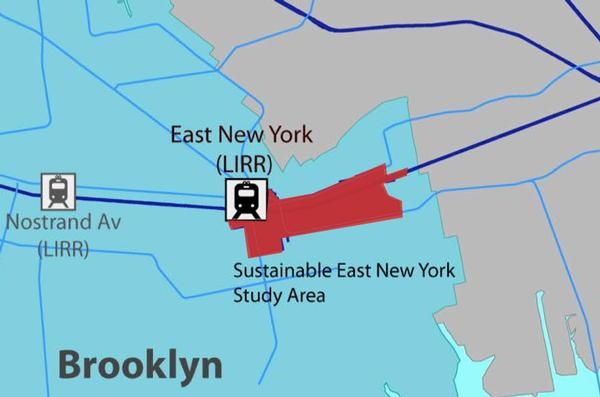
New Orleans 8 Years After Katrina| States Resist LEED Certifications | “Greening” City’s Vacant Lots

Sustainable East New York Study Area
- Why are some states trying to ban LEED Green building standards? The amendments and executive orders never actually mention LEED by name. They ban new construction built with public money from seeking (or requiring) any green building certification that’s not recognized by something called the American National Standards Institute, or that doesn’t treat all certifications for wood products equally. But that’s really just a mouthful meant to ensure no more LEED-certified courthouses or state offices or libraries.
- U.S. plan eases rules for mortgage lenders. Six federal regulatory agencies released a reworked proposal on Wednesday that would require lenders to maintain a stake in the loans they bundle and sell as securities, part of efforts to limit the type of underwriting practices that fed the housing bubble.
- Federal-funded effort may reshape East New York. Home to boarded buildings, sprawling autoshops, warehouses, light industry and gas stations, Atlantic Avenue in East New York is infamously bleak. Some intersections are dangerous for pedestrians to cross, and there are few trees or bus shelters. But change may be in store for the eastern segment of Atlantic Avenue and several other major boulevards including Fulton Avenue and Pitkin Avenue in East New York and the streets around the Broadway Junction subway station. After more than a year of community meetings, the Department of City Planning (DCP) released a presentation this March that outlines zoning changes to encourage high-density residential and commercial development in northern East New York and Cypress Hills. If pursued, the proposed changes would be publicly reviewed through the Uniform Land Use Review Procedure (ULURP).
- Turning unused acres green. The city of New York owns thousands of slivers of unused land, and about a year ago, a group of Brooklyn gardeners had an idea: identify all the vacant lots in the borough, then help neighborhood residents take them over. They built an online map, then a mobile app, with information about the plots, including the names and phone numbers of the agencies that owned them. They called themselves 596 Acres, after the total area of unused public land in Brooklyn, according to city data.
- Is ‘livable’ another word for boring? Melbourne: So lovely. So… livable. Every year, the Economist Intelligence Unit releases a list of 140 cities and ranks them in terms of their “livability.” For the third year running, Melbourne has topped the list, edging out Vienna and Vancouver. In fact, there was so little change in this year’s rankings that only 13 of all the surveyed cities changed their scores over the past six months, while the rankings of the top 10 cities remained exactly the same as last year.
- Bloomberg’s plan for bigger East Midtown towers is ‘zoning for dollars,’ group says. Mayor Michael R. Bloomberg’s plan to encourage construction of large new office towers around Grand Central Terminal as a way of keeping East Midtown commercially competitive amounts to an illegal game of “zoning for dollars,” the City Club of New York has asserted.
- The time in between: waiting after Katrina and Sandy. In New Orleans, Al Aubry and his family lived for almost three years in a FEMA trailer while they waited for their devastated home to be demolished so they could rebuild after Hurricane Katrina. Now, ten months after Hurricane Sandy, Deborah Turner and her family are also realizing that they may not get back into their home in Brick, New Jersey, anytime soon. Today, on the eighth anniversary of Hurricane Katrina, families across New York and New Jersey are asking some of the same questions that plagued Gulf Coast residents like Aubry. And perhaps the biggest question of all is, simply: When can I go home?
- Wall Street’s rental bet brings quandary housing poor. LaTanya Moore-Newsome, a real estate agent with Century 21 in Atlanta, has been calling Wall Street-backed landlords for months on behalf of her low-income clients with government housing vouchers. She said some of the area’s biggest homebuyers in the past two years, including Blackstone Group LP (BX), American Homes 4 Rent and Silver Bay Realty Trust Corp., repeatedly told her they had nothing available for tenants who use subsidies under the federal Section 8 assistance plan. Last week, she finally got a positive response from Blackstone’s Invitation Homes unit, which said it would accept applications from her renters.
- Council liberals target REBNY. The co-chair of the City Council’s Progressive Caucus fired a warning shot at the Real Estate Board of New York Monday in the form of a legislative proposal to severely limit the real estate industry’s ability to spend money on political campaigns. The council should seek to close the “LLC loophole” in state campaign finance law that allows many real estate corporations to give $150,000 to independent expenditures like REBNY’s “Jobs for New York” political action committee, according to a memo from Councilman Brad Lander.
- Resisting foreclosure: rising up for a dream called home. America’s current financial situation is not about one recovering economy; its a tale of two economies. One economy is soaring, breaking records of stock market and asset wealth. The other economy is barely holding on, as living-wage jobs - for those lucky enough to have them - are being replaced by employment that provides minimum-wage income that leaves families, in many cases, at the edge of or below the poverty level.


